
Central Asia is a subregion of Asia that stretches from the Caspian Sea in the southwest and Eastern Europe in the northwest to Western China and Mongolia in the east, and from Afghanistan and Iran in the south to Russia in the north. It includes Kazakhstan, Kyrgyzstan, Tajikistan, Turkmenistan, and Uzbekistan. The countries as a group are also colloquially referred to as the "-stans" as all have names ending with the Persian suffix "-stan" in both respective native languages and most other languages.

Kyrgyzstan, officially the Kyrgyz Republic, is a landlocked country in Central Asia, lying in the Tian Shan and Pamir mountain ranges. Bishkek is the capital and largest city of the country. Kyrgyzstan is bordered by Kazakhstan to the north, Uzbekistan to the west, Tajikistan to the south, and China to the east and southeast. Ethnic Kyrgyz make up the majority of the country's 7 million people, followed by significant minorities of Uzbeks and Russians.

The Economic Cooperation Organization or ECO is a Eurasian political and economic intergovernmental organization that was founded in 1985 in Tehran by the leaders of Iran, Pakistan, and Turkey. It provides a platform to discuss ways to improve development and promote trade and investment opportunities. The ECO is an ad hoc organisation under the United Nations Charter. The objective is to establish a single market for goods and services, much like the European Union. After the dissolution of the Soviet Union, the ECO expanded to include Afghanistan, Azerbaijan, Kazakhstan, Kyrgyzstan, Tajikistan, Turkmenistan, and Uzbekistan in 1992.

Soviet Central Asia was the part of Central Asia administered by the Soviet Union between 1918 and 1991, when the Central Asian republics declared independence. It is nearly synonymous with Russian Turkestan in the Russian Empire. Soviet Central Asia went through many territorial divisions before the current borders were created in the 1920s and 1930s.

The Lyuli, Jughi or Jugi are a branch of the Ghorbati people living in Central Asia, primarily Tajikistan, Uzbekistan, Turkmenistan, Kazakhstan, and southern Kyrgyzstan; also, related groups can be found in Turkey, and the Balkans, Crimea, Southern Russia and Afghanistan. They speak ethnolects of the Persian and Turkic language and practice Sunni Islam. The terms Lyuli and Jugi are considered pejorative. They have a clan organization. Division into sub-clans is also practiced. The Lyuli community is extremely closed towards non-Lyuli.

The Central Asian Union (CAU), later called the Central Asian Economic Union, was an intergovernmental organization for economic integration between the Central Asian post-Soviet republics of Kazakhstan, Kyrgyzstan and Uzbekistan between 1994 and 2004. Tajikistan joined the Union in 1996 as an observer. Several proposals to restore the Union have been put forward since its dissolution.
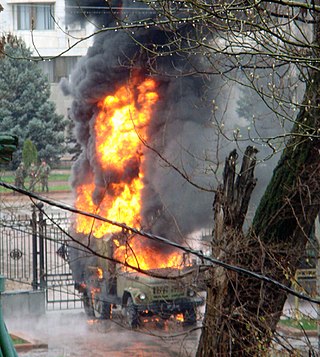
The 2010 Kyrgyz Revolution, also known as the Second Kyrgyz Revolution, the Melon Revolution, the April Events or officially as the People's April Revolution, began in April 2010 with the ousting of Kyrgyz president Kurmanbek Bakiyev in the capital Bishkek. It was followed by increased ethnic tension involving Kyrgyz people and Uzbeks in the south of the country, which escalated in June 2010. The violence ultimately led to the consolidation of a new parliamentary system in Kyrgyzstan.
The Cinema of Central Asia usually refers to the cinema of five Central Asian countries. Central Asian cinema can further be divided into three historical periods, Soviet Central Asian film (1919–1987), a New Wave of Central Asian film (1988–1992), and the modern period of film of the independent Central Asian countries (1992–present).
Armenians in Central Asian states: Uzbekistan, Kazakhstan, Kyrgyzstan, Tajikistan and Turkmenistan, were mainly settled there during the Soviet era for various reasons.

Much of the influence of the Soviet Union can be seen in the infrastructure of Central Asia. Central Asia is a nexus of said infrastructure for transportation, goods delivery and energy distribution. Much of the industrial infrastructure had greatly declined in the 1990s, after the fall of the Soviet Union, especially in Kyrgyzstan and Tajikistan. The roads, railroads and energy lines are thus oriented towards the Russian Federation and away from other regional neighbors, such as China, Afghanistan or Iran.
The history of the Jews in Central Asia dates back centuries, where Jews have lived in countries which include Kyrgyzstan, Kazakhstan, Tajikistan, Turkmenistan, and Uzbekistan.
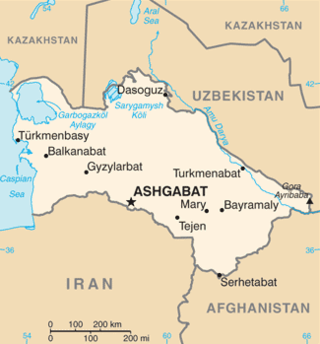
The Kazakhstan–Turkmenistan border is 413 kilometres (257 mi) in length and runs from the Caspian Sea to the tripoint with Uzbekistan. It is the shortest international boundary of both states.

The Turkmenistan–Uzbekistan border is the border between the countries of Turkmenistan and the Republic of Uzbekistan. At 1,793 km, it is Turkmenistan's longest border and Uzbekistan's second longest. The border runs from the tripoint with Kazakhstan to the tripoint with Afghanistan.
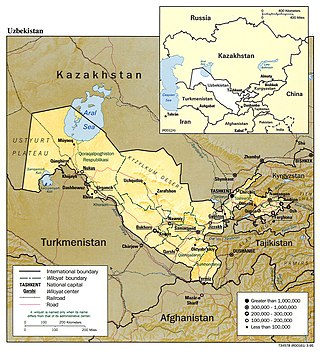
The Kazakhstan–Uzbekistan border is 2,330 km (1,450 mi) long and runs from the tripoint with Turkmenistan to the tripoint with Kyrgyzstan. It is Uzbekistan's longest external boundary. The Uzbek capital Tashkent is situated just 13 km (8.1 mi) from this border.
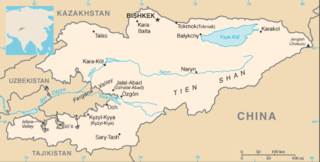
The Kazakhstan–Kyrgyzstan border is 1,212 kilometres (753 mi) and runs from the tripoint with Uzbekistan to the tripoint with China. Bishkek, the Kyrgyz capital, is situated just 16 km to the south of this boundary, and Almaty is situated just 29 kilometres (18 mi) to the north of it.
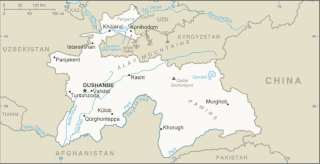
The Tajikistan–Uzbekistan border is an international border between Tajikistan and Uzbekistan. It is 1,312 kilometres (815 mi) in length and runs from the tripoint with Kyrgyzstan to the tripoint with Afghanistan.

The Kyrgyzstan–Uzbekistan border is 1,314 kilometres (816 mi) in length and runs from the tripoint with Kazakhstan to the tripoint with Tajikistan. It is Kyrgyzstan's longest external boundary.

The border between Kyrgyzstan and Tajikistan is 984 kilometres (611 mi) long and runs from the tripoint with Uzbekistan to the tripoint with China.
Central Asians in the United States are Americans with ancestry from Central Asia. They include Kazakh, Kyrgyz, Tajik, Turkmen, and Uzbek individuals. People of Afghan, Baloch, and Uyghur descent are also sometimes classified as Central Asians. The United States census does not mention Central Asians under any category.












